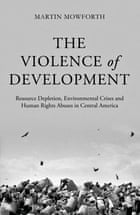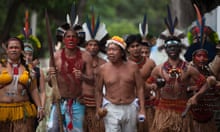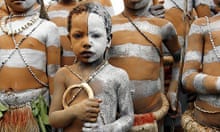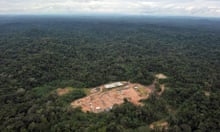Indigenous groups are now represented globally by a range of international organisations – the United Nations Permanent Forum on Indigenous Issues (UNPFII), the Assembly of First Nations, Survival International, the World Council of Indigenous Peoples, Indigenous Environmental Network – and by many national organisations, along with a host of declarations on indigenous issues by UN agencies and international groups.
Acceptance in Latin American nation states of a multicultural citizenship which is inclusive of indigenous groups has become standard practice on the statute books. A range of rights has been accorded by Central American governments to their indigenous populations. In most cases the recognition is only on paper. The Honduran government, for instance, sidesteps its legal obligations to indigenous populations and their communal land rights by legislating in favour of individual ownership, which directly undermines the principle of communal ownership in indigenous territories.
It is clear that indigenous peoples have been recognised; but it is also clear that legal recognition does not mean that the rights, territories, resources and cultures of indigenous peoples are respected. Governments, corporations, loggers, campesino farmers, cattle-ranching companies and many others still covet their land and resources, and continue to find ways to acquire them.
The resurgence of indigenous self-esteem which has accompanied these developments has coincided with the global financial crisis. The crisis has reinforced "a battle [that] is taking place for natural resources everywhere". As Victoria Tauli-Corpus (an indigenous Filipino and UNPFII chair) says:
"There are more and more arrests, killings and abuses. This is happening in Russia, Canada, the Philippines, Cambodia, Mongolia, Nigeria, the Amazon, all over Latin America, Papua New Guinea and Africa. It is global. We are seeing a human rights emergency ... Much of the world's natural capital – oil, gas, timber, minerals – lies on or beneath lands occupied by indigenous people."

The emergency takes the form of land evictions, displacements, forced relocations, and state and corporate violence against indigenous groups. Such conflicts in Central America are frequent and violent, but are rarely covered in the international press. Behind the protests there generally lurk concerns over natural resources or contamination from the activities of mining, oil, energy, logging and agribusiness.
It is this battle, this crisis over land and natural resources, which principally explains why indigenous issues are also environmental and development issues.
Poverty is a development and environmental issue, but the definition of poverty with respect to indigenous peoples is contentious. By the widely used UN standards, indigenous peoples suffer a consistently higher degree of financial poverty than the rest of society. Jason Paiement describes indigenous peoples as:
"Among the poorest and most excluded populations in the world. They have almost universally suffered injustices and discrimination in terms of their basic rights to life, property, languages, culture and citizenship. Many continue to be denied access to essential services such as healthcare and education, and the material conditions for living a satisfying life."
Yet indigenous peoples have expressed that "they do not like to be labelled as poor because of its negative and discriminatory connotations highlighting instead the process of impoverishment caused by dispossession of their ancestral lands, loss of control over their natural resources and indigenous knowledge, and their forced assimilation into mainstream society and integration in the market economy," according to Joji Cariño.
Vandana Shiva distinguishes between poverty as subsistence and misery through scarcity and want:
"It is helpful to distinguish between a cultural concept of a simple and sustainable life, understood as poverty, from the material experience of poverty as a result of dispossession and scarcity ... [S]ubsistence economies which satisfy basic needs by means of self-supply are not poor in the sense that they are wanting. The ideology of development, however, declares them to be poor for not participating significantly in the market economy and for not consuming goods produced in the global economy."
Many indigenous groups and representatives are keen to improve the state's and society's acceptance of indigenous peoples and issues, but are clear that this does not mean that they wish to join what a NACLA report describes as "the misplaced social and economic priorities of neoliberal capitalism". This echoes many groups representing indigenous peoples that, while they want recognition of their cultures by the dominant society, they do not wish to participate in an economic model which is likely to exploit their labour, land and resources for the benefit of a small powerful group. It is of course relatively easy to find individual exceptions to this general feeling, particularly among the young, some of whom see exciting chances to make money.
An issue of contention is the coincidence and conflict between conservation strategies and indigenous peoples. The fact that areas inhabited by indigenous peoples are often also deemed crucial for conservation has been the focus of long-standing conflict and debate. It is estimated that 85% of designated protected areas in Central America are inhabited by indigenous peoples. That the subsistence lifestyles of indigenous peoples are less destructive to the environment than the agro-industrialised economies of non-indigenous peoples should not surprise anyone.
It is often noted that indigenous peoples have an intuitive relationship with nature, a wealth of traditional knowledge, and have used natural resource management practices for centuries to preserve their lands. The stewardship role of indigenous peoples strongly supports the possibility of collaboration with conservation organisations for maintaining biodiversity. Mark Dowie contends that for both parties, maintaining a "healthy and diverse biosphere" is key. Furthermore, the land and ecosystems that both conservationists and indigenous peoples are so keen to defend are seriously threatened by multiple demands, including intensive agriculture, industrial forestry and large-scale development projects such as dams and mines.
But it has been suggested that there are inherent and irreconcilable differences in the agendas of indigenous peoples and conservationists. While the former are primarily concerned for their economic well-being and protecting their land for their own use, the latter want to keep nature intact, prioritising protected areas and programmes grounded in biological and ecological science.
Mac Chapin (pdf) provides a damning critique of the three largest and dominant global conservation organisations: World Wildlife Fund, Conservation International and Nature Conservancy. He noted that their neglect of indigenous peoples in conservation programmes is partly due to their corporate and government funding and the conditions attached to it. He points out that indigenous resistance is often directed at projects executed by the organisations' funding partners, who are also often perpetrators of environmental degradation.








Comments (…)
Sign in or create your Guardian account to join the discussion